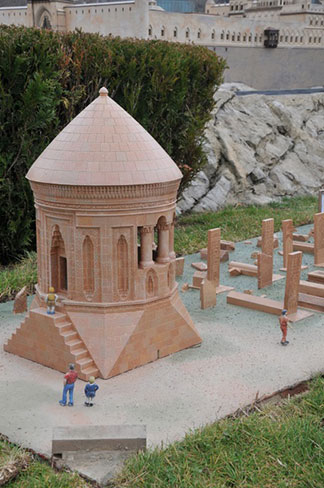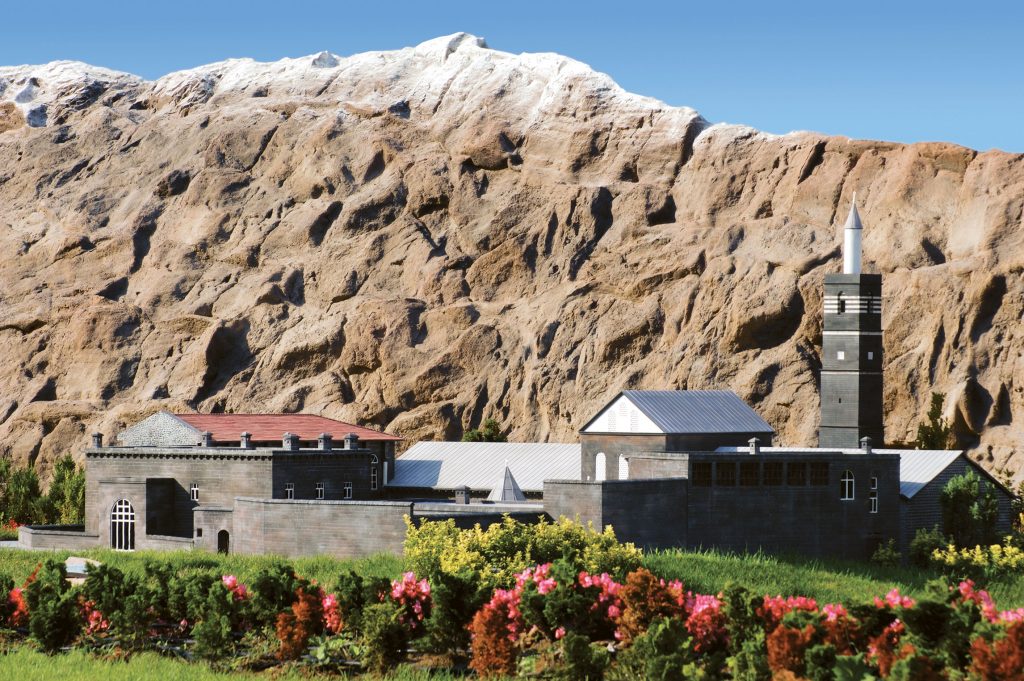-
Welcome to Miniaturk
- iletisim@kultur.istanbul
- +90 212 222 28 82
Welcome to Miniaturk

Maiden Castle has been an important settlement area which has been dominated by Selevcans, Romans, Byzantines, Seljuks, Armenians, French (Kingdom of Cyprus), Karamans and Ottomans in history. It was built in 4th century BC. The famous historian, Herodotus claimed that this city was established by a Cypriot prince named Georges. During the Byzantine era, the surrounding city walls were built against the Arab attacks.

Zeynel Bey Mausoleum was built in the name of Zeynel Bey, the son of Uzun Hasan, the Akkoyunlu ruler between 1462 and 1482, who died in the Battle of Otlukbeli. The tomb attracts attention with its trunk embellishment, which has eye-catching colors. The complex contains 3 madrasahs, 1 imaret, 1 tomb, 1 inn and 1 Turkish bath which was built on edge of the Tigris River.

It was built by the Roman Emperor Hadrian in the 2nd century BC. The bridge was connected to Adana Castle with the additions made later on. The bridge has been an important structure connecting the trade routes of the era. There are 21 arches on this 319 meters long and 13 meters high bridge. There are two lion reliefs on the large arch in the middle. Today only 14 of these arches are standing.

The tomb, which was built in 1322, is in Kırşehir. It belongs to the Eretna Principality. It was made of cut stone, and has a resemblance of Central Asian architecture. It was made in the name of Âşık Pasha, a Sufi and folk poet known for his research on the Turkish language. The oyster shell shaped crown gate attracts attention with its beauty.

It is a work from Akkoyunlu period. The tomb was built by his wife Şah Selime Hatun in the name of Emir Bayındır (died in 1481), the son of Rustem Bey, the grandson of Uzun Hasan, the ruler of Akkoyunlus. It is also known as “tomb with columns”. A master called “Babacan” from Ahlat built it. The tomb is separated from the others in Anatolia by its vaulted and columned structure. The Ahlat Seljuklu Square Cemetery consists of approximately 8000 tombstones and 178 types of underground graves in various typologies, with an artisan signature of 435, dating from the 11th to the 16th century. It is known as the biggest monumental cemetery of Islamic world.

It is in Şanlıurfa, which is a sacred city for three big religions. The Halilürrahman Mosque, was built in 1211 with cut stone near Zeliha Lake whose fish population is considered sacred. It was built by Salahaddin Ayyubi’s favorite niece Melik Eşref Muzaffereddin Musa.

The mosque is located on the west side of the axis connecting the Harput Gate and the Mardin Gate on the Diyarbakır Walls. It is also the oldest mosque in Anatolia. The mosque was repaired many times as it was shown on about 20 inscriptions from Seljuk, Artuklu, Akkoyunlus, Karakoyunlu and Ottoman periods. The great mosque of Diyarbakir is known as the 5th Harem-I-Sharif of Islamic world.

It was built in 1421 near the Bursa Green Mosque. Mehmed Çelebi the 1st died in 1421, 40 days after completion of the tomb. There are 8 sarcophagus in the tomb. There is an inscription written in gold on the sarcophagus.

The largest mosque in Bursa was opened in 1400. It was built with war gains by Yıldırım Bayezid after the Niğbolu Victory, as a gift for the people of the region. Süleyman Çelebi, the writer of the Mevlid-i Sharif, was the imam of this mosque throughout his life. This mosque is famous for its walnut carved minbar and line plates.

Somuncu Baba gets his name for the breads he gave to the public free of charge while he was in Bursa. He died in 1412 in Darende. The tomb is here, located inside the mosque. Sheikh Hamid-i Veli and his son Halil Taybi’s graves are also located here. The spring water which comes from the rock just behind the tomb in the mosque is transferred through a channel to the natural fountain to the right of the door entrance and used for ablution.

It is located in Selçuk between Artemis Temple and Christian church Saint Jean. It was built by Aydınoğlu İsa Bey in 1375. It is the work of the Architect Şamlı Ali. The mosque is located on the hillside and two entrance gates are on the western and eastern sides. The western gate is decorated with writings and geometric shapes. The western walls are covered with marble and the other walls are made of cut stone.

When İbrahim Hakkı’s teacher died, he had a tomb built in his name, and he willed to be buried next to his teacher’s feet. The mausoleum consists of two small rooms, one large hall covered by one big and two small domes, and a tower with eight corners which is 10 meters high.